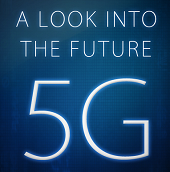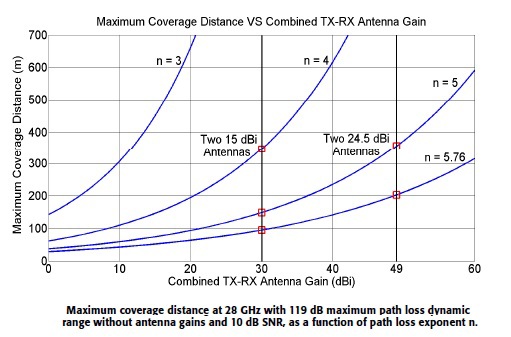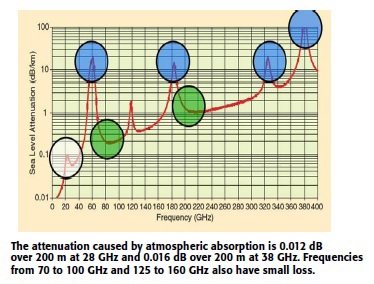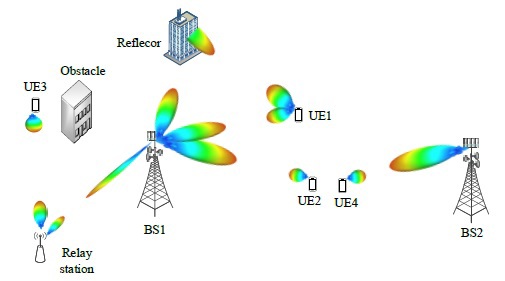5G radio interface
One of the most important features of promising 5th generation networks has been considered: the use of the millimeter frequency range.
The article is based on the author’s personal experience in studying the appearance of future 5G networks in one of the leading European universities and in communicating with people directly involved in this field. In view of the meager number of technical publications on the topic of the 5G radio interface in Russian (which is very sad), the author hopes that the article will be useful to all interested.

5th generation (5G) wireless technologies are expected to begin to enter our lives in 2020. They will have to bring the quality of services provided to a whole new level, and all this in the conditions of an exponential growth of traffic in mobile communication networks and an increasing number of devices connected to such networks.
It is important to note that 5G developers are thinking about the long term, so that 5G in the future will be so flexible and “powerful” that they can create the infrastructure for such applications that we are just starting to think about today. For example, research is underway on how 5G will become an important component in the future for the infrastructure of unmanned vehicles.
At the level of the concept developed in the framework of the European METIS project [1], there are three main basic services (generic 5G services) provided by 5G networks that differ in different requirements for network parameters:
The latter two are especially important in the context of the currently fashionable concept of the Internet of Things.
By the way, at the beginning of July, the second phase of the project, METIS-II, started, according to the results of which a more or less final appearance of the 5G radio access network will be determined.

In general, the very possibility of such highly advanced infrastructure services will have to be based on four key principles [1]:
Currently, a consensus has been reached among developers and researchers that future 5G networks will go (only partially) to the microwave frequency ranges (3-30 GHz, 10-1 cm) and possibly even EHF (30-300 GHz, 10-1 mm ), [2]. The use of such exotic frequency ranges for mobile radio communications requires a review of the principles of radio access at both the physical and MAC levels.
For a general understanding of the situation in this range, the graphs published in [3] are given below. The first graph shows that under various conditions, the communication range at a frequency of, say, 28 GHz, is measured in hundreds of meters, although when using antenna systems with a high gain and with direct visibility, the range can significantly increase (according to some reports, up to 1-2 km in Microwave range).

On top of that, millimeter waves (mmWaves) are characterized by a noticeable attenuation in the atmosphere, as shown in the following graph. What can we say about attenuation in obstacles.

Thus, reliable communication in the millimeter range requires the use of narrow beams with direct visibility. Or, at a minimum, the use of rays reflected from objects in the immediate vicinity of the proximity transmitter. Fig. from [4]:

Obviously, this in turn entails the widespread use of “ultra-dense network solutions”: femto and pico cells (to reduce the required range), coupled with highly directional antennas both on the transmitter and on the receiver if the latter is possible (to increase the achievable range and even overlap the requirements for this parameter in small cells).
В таком сценарии «полнонаправленной радиосвязи» (fully-directional communication) поддержанной еще и новыми протоколами MAC уровня (т.к. при работе на прямой видимости и на узком радиолуче меняются протоколы доступа к среде, однако это тема отдельного разговора) разработчики приходят к новой концепции ограниченной по шуму сетевой архитектуры (noise-limited network architecture) вместо принятой сегодня архитектуры, ограниченной по интерференции (interference-limited), а так же абонент-ориентированного дизайна (user-centric design) вместо сегодняшего дизайна, ориентированного на соту (или сектор) (cell-centric design). [4]. И наконец из-за высокой направленности и динамического характера будущих сетей 5G, само понятие «сота» так же будет пересмотрено (об этом будет сказано ниже).
Due to the short wavelengths in the millimeter range, smaller antenna systems can be used in 5G systems. In particular, special interest and efforts today are riveted to the technology of multi-element MIMO antennas (Massive-MIMO). The use of such antenna technologies can effectively solve the problems of full directional radio communications and interference. On the other hand, the need to work in such high ranges entails a rise in price and complication of specific circuitry solutions. In fig. The first prototype of a multi-element MIMO system with the number of elements over 100 (apparently, simple patch antennas) is shown (taken from here www.designworldonline.com/a-new-way-to-accelerate-5g-research ):

However, full direction radio communication has two significant limitations:
The classical understanding of a cell or sector, based on the criteria of the minimum distance and the adoption of the condition for an even distribution of the probability of the location of subscribers in the coverage area, becomes practically useless in view of the following fundamental factors:
5G networks will provide a greater number of degrees of freedom in terms of access to resources, which means that the parameters of the cell / sector and, in particular, their boundaries will be determined as a result of dynamic optimization algorithms to maximize / minimize some objective function. In accordance with the requirements for the quality of service, such a target system function can be determined by the following network parameters (or a combination of them): latency, reliability, power consumption, data transfer rate, uniformity of the quality of customer service, etc.

Moreover, it is assumed that the decision about which system function should be optimized will be made on the basis of what kind of service the subscriber is using at a given time. Thus, the network configuration that meets the requirements of a particular service may not be carried out by the telecom operator, but directly by the service provider through the API within the framework of the Software Defined Wireless Networking (SDWN) concept.
Apparently, the optimal approach is that in which 5G networks will adaptively take advantage of both the "new" and the "old" ranges. This is consistent with another 5G principle - heterogeneity . On the other hand, this approach will provide interfacing with existing wireless access systems.
[1] METIS Deliverable D 2.4, “METIS final project report”, April 30, 2015.
[2] METIS Deliverable D 2.4, “Proposed solutions for new radio access,” February 28, 2015.
[3] TS Rappaport et al., “ Millimeter Wave Mobile Communications for 5G Cellular: It Will Work! ”, IEEE Access, vol. 1, May 2013, pp. 335–49.
[4] H. Shokri-Ghadikolaei, C. Fischione et al., “Millimeter Wave Cellular Networks: A MAC Layer Perspective” Submitted in IEEE Transactions on Communications on March 3, 2015.
The article is based on the author’s personal experience in studying the appearance of future 5G networks in one of the leading European universities and in communicating with people directly involved in this field. In view of the meager number of technical publications on the topic of the 5G radio interface in Russian (which is very sad), the author hopes that the article will be useful to all interested.

5th generation (5G) wireless technologies are expected to begin to enter our lives in 2020. They will have to bring the quality of services provided to a whole new level, and all this in the conditions of an exponential growth of traffic in mobile communication networks and an increasing number of devices connected to such networks.
It is important to note that 5G developers are thinking about the long term, so that 5G in the future will be so flexible and “powerful” that they can create the infrastructure for such applications that we are just starting to think about today. For example, research is underway on how 5G will become an important component in the future for the infrastructure of unmanned vehicles.
At the level of the concept developed in the framework of the European METIS project [1], there are three main basic services (generic 5G services) provided by 5G networks that differ in different requirements for network parameters:
- Ultra-wideband mobile communication (Extreme Mobile Broadband - xMBB);
- Massive Machine-Type Communications (mMTC);
- Ultra-reliable inter-machine communication (Ultra-reliable MTC - uMTC).
The latter two are especially important in the context of the currently fashionable concept of the Internet of Things.
By the way, at the beginning of July, the second phase of the project, METIS-II, started, according to the results of which a more or less final appearance of the 5G radio access network will be determined.

In general, the very possibility of such highly advanced infrastructure services will have to be based on four key principles [1]:
- An “economical” approach to network management to reduce signaling traffic and associated overhead;
- Flexible network connection when devices perform not only terminal but also infrastructure functions;
- Localization of content to reduce load, delays and the ability to aggregate traffic;
- The introduction of new approaches to the use of the frequency resource.
1. Transition to the millimeter range - full direction communication
Currently, a consensus has been reached among developers and researchers that future 5G networks will go (only partially) to the microwave frequency ranges (3-30 GHz, 10-1 cm) and possibly even EHF (30-300 GHz, 10-1 mm ), [2]. The use of such exotic frequency ranges for mobile radio communications requires a review of the principles of radio access at both the physical and MAC levels.
For a general understanding of the situation in this range, the graphs published in [3] are given below. The first graph shows that under various conditions, the communication range at a frequency of, say, 28 GHz, is measured in hundreds of meters, although when using antenna systems with a high gain and with direct visibility, the range can significantly increase (according to some reports, up to 1-2 km in Microwave range).

On top of that, millimeter waves (mmWaves) are characterized by a noticeable attenuation in the atmosphere, as shown in the following graph. What can we say about attenuation in obstacles.

Thus, reliable communication in the millimeter range requires the use of narrow beams with direct visibility. Or, at a minimum, the use of rays reflected from objects in the immediate vicinity of the proximity transmitter. Fig. from [4]:

Obviously, this in turn entails the widespread use of “ultra-dense network solutions”: femto and pico cells (to reduce the required range), coupled with highly directional antennas both on the transmitter and on the receiver if the latter is possible (to increase the achievable range and even overlap the requirements for this parameter in small cells).
В таком сценарии «полнонаправленной радиосвязи» (fully-directional communication) поддержанной еще и новыми протоколами MAC уровня (т.к. при работе на прямой видимости и на узком радиолуче меняются протоколы доступа к среде, однако это тема отдельного разговора) разработчики приходят к новой концепции ограниченной по шуму сетевой архитектуры (noise-limited network architecture) вместо принятой сегодня архитектуры, ограниченной по интерференции (interference-limited), а так же абонент-ориентированного дизайна (user-centric design) вместо сегодняшего дизайна, ориентированного на соту (или сектор) (cell-centric design). [4]. И наконец из-за высокой направленности и динамического характера будущих сетей 5G, само понятие «сота» так же будет пересмотрено (об этом будет сказано ниже).
2. Multi-element MIMOs - Another Key Technology
Due to the short wavelengths in the millimeter range, smaller antenna systems can be used in 5G systems. In particular, special interest and efforts today are riveted to the technology of multi-element MIMO antennas (Massive-MIMO). The use of such antenna technologies can effectively solve the problems of full directional radio communications and interference. On the other hand, the need to work in such high ranges entails a rise in price and complication of specific circuitry solutions. In fig. The first prototype of a multi-element MIMO system with the number of elements over 100 (apparently, simple patch antennas) is shown (taken from here www.designworldonline.com/a-new-way-to-accelerate-5g-research ):

3. Problems of full directional mobile communications and their possible solutions
However, full direction radio communication has two significant limitations:
- Blocking the channel of direct visibility (Blockage) due to various obstacles on the highway. To overcome this unpleasant situation, alternative ways of signal transmission should be found both using beamforming techniques for working on the reflected beam and applying new approaches to handover and tracking of a subscriber in motion. For example, a network can communicate with a mobile station (MS) through several base stations (BS) at the same time.
- "Deafness" (Deafness). The narrow main lobes of the antenna bottoms on MS and BS should be directed exactly at each other, otherwise they simply will not “hear” each other. The solution to this problem looks more complicated because requires new approaches for connection procedures. For example, in modern networks, the formation of a narrow beam of the beam occurs only after synchronization using an omnidirectional control channel in the VHF range. However, in 5G networks, such a strategy will lead to problems due to different communication ranges and (more importantly) different signal propagation conditions in two different VHF and microwave ranges.
4. Review of planning principles
The classical understanding of a cell or sector, based on the criteria of the minimum distance and the adoption of the condition for an even distribution of the probability of the location of subscribers in the coverage area, becomes practically useless in view of the following fundamental factors:
- Seals infrastructure, especially in urban environments;
- High directivity radio communications;
- Heterogeneity in radio networks.
5G networks will provide a greater number of degrees of freedom in terms of access to resources, which means that the parameters of the cell / sector and, in particular, their boundaries will be determined as a result of dynamic optimization algorithms to maximize / minimize some objective function. In accordance with the requirements for the quality of service, such a target system function can be determined by the following network parameters (or a combination of them): latency, reliability, power consumption, data transfer rate, uniformity of the quality of customer service, etc.

Moreover, it is assumed that the decision about which system function should be optimized will be made on the basis of what kind of service the subscriber is using at a given time. Thus, the network configuration that meets the requirements of a particular service may not be carried out by the telecom operator, but directly by the service provider through the API within the framework of the Software Defined Wireless Networking (SDWN) concept.
5. Conclusion
Apparently, the optimal approach is that in which 5G networks will adaptively take advantage of both the "new" and the "old" ranges. This is consistent with another 5G principle - heterogeneity . On the other hand, this approach will provide interfacing with existing wireless access systems.
References
[1] METIS Deliverable D 2.4, “METIS final project report”, April 30, 2015.
[2] METIS Deliverable D 2.4, “Proposed solutions for new radio access,” February 28, 2015.
[3] TS Rappaport et al., “ Millimeter Wave Mobile Communications for 5G Cellular: It Will Work! ”, IEEE Access, vol. 1, May 2013, pp. 335–49.
[4] H. Shokri-Ghadikolaei, C. Fischione et al., “Millimeter Wave Cellular Networks: A MAC Layer Perspective” Submitted in IEEE Transactions on Communications on March 3, 2015.
